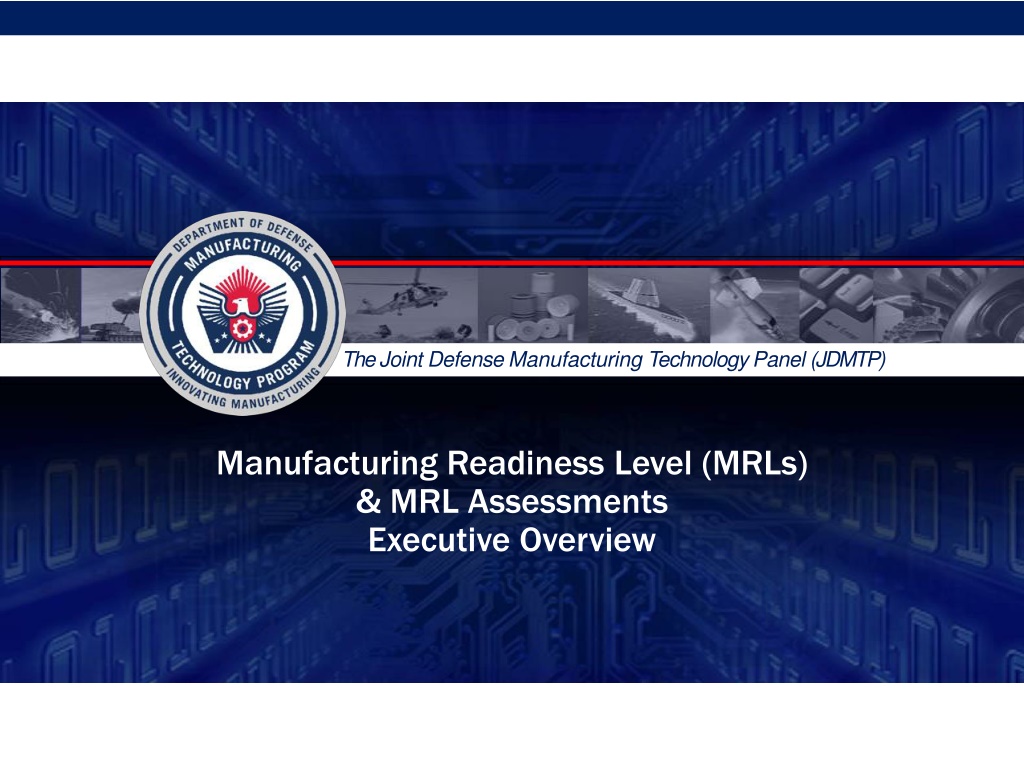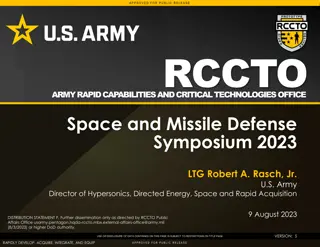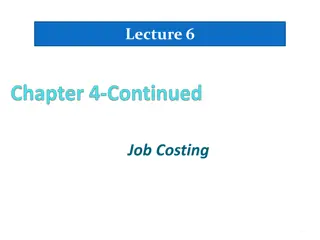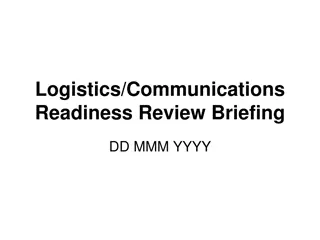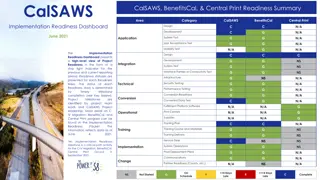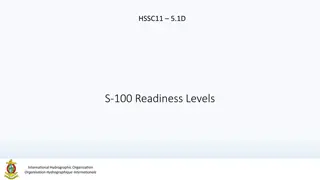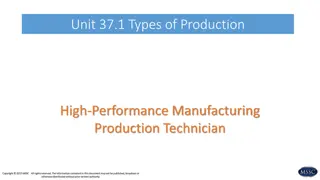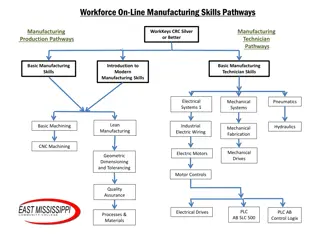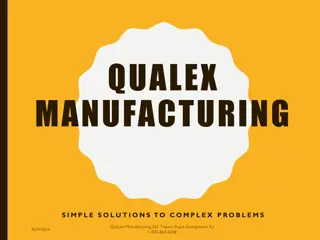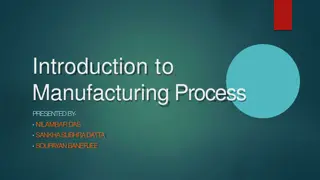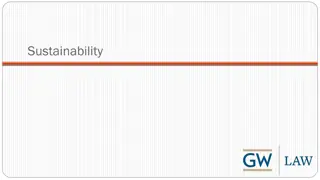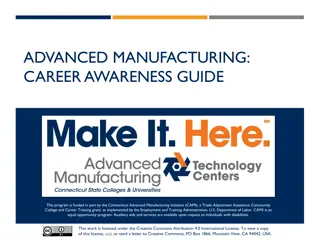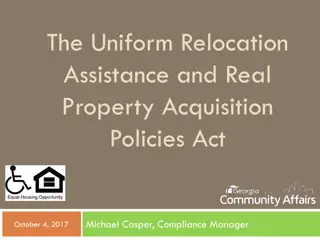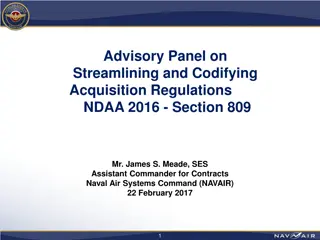Understanding Manufacturing Readiness Levels (MRLs) in Defense Acquisition
The Joint Defense Manufacturing Technology Panel (JDMTP) establishes Manufacturing Readiness Levels (MRLs) as a risk identification tool for assessing the manufacturing maturity, risks, and capabilities related to defense technology production. MRLs provide decision-makers with a common understanding of technology readiness, transitioning from concept to full-rate production. The MRL evaluation threads encompass technology maturity, design producibility, production cost knowledge, and materials considerations.
- Manufacturing Readiness Levels
- Defense Technology
- Risk Assessment
- Defense Acquisition
- Maturity Evaluation
Download Presentation

Please find below an Image/Link to download the presentation.
The content on the website is provided AS IS for your information and personal use only. It may not be sold, licensed, or shared on other websites without obtaining consent from the author. Download presentation by click this link. If you encounter any issues during the download, it is possible that the publisher has removed the file from their server.
E N D
Presentation Transcript
The Joint Defense Manufacturing Technology Panel (JDMTP) Manufacturing Readiness Level (MRLs) & MRL Assessments Executive Overview
What are MRLs? Common language and standard for: Assessing the manufacturing maturity of a technology or product and the plans for its future maturation Helping to understand the level of manufacturing risk in producing a system or transition technology into a system application Designed to complement Technology Readiness Levels Not pass/fail criteria Designed to provide decision makers (at all levels) with a common understanding of the relative maturity (and attendant risks) associated with manufacturing technologies, products, and processes A Risk Identification Tool
MRL Relationships Defense Acquisition Phases Defense Acquisition Phases System Acquisition Milestones System Acquisition Milestones A B C Technology Maturation & Risk Reduction Engineering & Manufacturing Development Capabilities Based Planning /Concept Development Materiel Solution Analysis Production & Deployment/ Operations & Support MRL 3 MRL 4 Manufacturing Processes In Lab Environment MRL 5 Components In Production Relevant Environment MRL 6 System or Subsystem In Production Relevant Environment MRL 7 System or Subsystem In Production Representative Environment MRL 8 Pilot Line Demonstrated Ready for Low Rate Initial Production (LRIP) MRL 9 LRIP Demonstrated Ready for Full Rate Production (FRP) MRL 10 FRP Demonstrated Lean Production Practices in Place MRL 2 MRL 1 Manufacturing Proof of Concept Developed Manufacturing Concepts Identified Basic Manufacturing Implications Identified Manufacturing Readiness Levels Manufacturing Readiness Levels Manufacturing Readiness Levels TRL 1 TRL 2 TRL 3 TRL 4 TRL 7 TRL 5 TRL 6 TRL 8 TRL 9 Basic Principles Observed Proof of Concept Breadboard in Lab Prototype in Operational Environme nt Concept Formulation Breadboard in Relevant Environment Prototype in Relevant Environment Mission Proven System Qualification Technology Readiness Levels Technology Readiness Levels
9 MRL Evaluation Threads A. Technology and Industrial Base Technology maturity, technology transition to production, ManTech development B. Design Producibility program, design maturity C. Cost and Funding Production cost knowledge (cost modeling), cost analysis, mfg investment budget D. Materials (raw materials, components, subassemblies, subsystems) Maturity, availability, supply chain management, special handling E. Process Capability and Control Modeling & Simulation (product & process), mfg process maturity, process yields/rates F. Quality Management, to include supplier quality G. Manufacturing Personnel, to include specialization, training, & certification H. Facilities, to include capacity and plant layout & design I. Manufacturing Management Manufacturing planning and scheduling Materials planning Tooling and special test equipment Operational Technology Cybersecurity
MRL Manufacturing Environment Definitions Terms defined by the MRL Deskbook: Laboratory Environment An environment where scientists, design engineers, manufacturing engineers, quality engineers, and production personnel develop and test processes, procedures, and equipment for making a product. ~ MRL 1 - 4 Production Relevant An environment with some shop floor production realism present (such as facilities, personnel, tooling, processes, materials etc.). ~ MRL 5 & 6 Production Representative An environment that has as much production realism as possible, considering the maturity of the design. ~ MRL 7 Pilot Line An environment that incorporates all of the key production realism elements (equipment, personnel skill levels, facilities, materials, components, work instructions, processes, tooling, cleanliness, lighting etc.). ~ MRL 8 Production Line An environment that incorporates all capabilities required to manufacture production configuration items, subsystems, or systems. ~ MRL 9 & 10
MRL Body of Knowledge Deskbook Narrative document: Defines MRLs and Criteria Explains Manufacturing Readiness Assessment (MRA) process and Manufacturing Maturation Plan (MMP) format Provides contracting language and tailoring guidelines Living document Contains MRL Criteria Matrix as an appendix The MRL Body of Knowledge is at: dodmrl.org
MRL Body of Knowledge Criteria Matrix Excel spreadsheet containing all criteria organized by: MRL timeline (column) Subject thread (row) Included within the MRL User s Guide file at dodmrl.org
MRL BoK Users Guide Interactive document Supports MRL assessments: Contains cross-referenced definitions, criteria, explanatory notes, best practices and MRL appropriate questionnaires Mimics Criteria Matrix Has: Printable Criteria Matrix MRL Questionnaire Pop-Ups with additional information for each criteria
MRL Assessment Conceptual View Identify Product or Processes (WBS, etc.) Identify Items to be Assessed (CTE, WBS or Filter Questions) Develop Risk Mitigation Plan(s) [Manufacturing Maturation Plan(s)] Identify Program Phase Conduct Assessment Assess Risk Determine MRL Criteria Monitor & Follow-Up
MRL Assessment Goal Identify the As-Is State: defines the current level of manufacturing maturity Determine the Should-Be State (i.e., Target MRL) Identify gaps and maturity shortfalls (if any) and associated risk drivers Develop strategies to reach the Should-Be State Provides the basis for manufacturing maturation and risk management Includes planning, identification, analysis, mitigation, implementation, and tracking
The Assessment Process Self-assessment Based on Target MRL and Criteria Matrix User s Guide and Deskbook expound on criteria and provide appropriate hooks to guidance Identifies supporting evidence/artifacts MRA Team reviews self-assessment before on-site assessment Provides feedback to company On-site Assessment Company presents summary MRL assessment, company info, and facility tour Demonstrate evidence on the production floor Determine As-Is MRL using Criteria Matrix Begin MMP strategy/risk discussion (i.e., start MMP development)
Post-Assessment Activities As a Best Practice, Program Office/Contractor/ Supplier will normally collaborate to develop the Manufacturing Maturity Plan (MMP) for MRLs which do not meet the target MRL level. MMPs address: Activities to reach MRL target Schedule and Costs Considerations for the Milestone Decision Authority (MDAs)
The Deployment of MRLs The MRL Deskbook methodology is recognized and used by both government and commercial industry SAE Industry Standard AS6500 (Manufacturing Management Program) contains MRLs as a requirement Some Service instructions require MRLs on acquisition contracts Congressional language in law requires MRLs on some specific acquisition programs GAO identifies the use of MRLs as a Best Practice MRLs are a Best Practice across Defense and Commercial Industries
Summary Key manufacturing activities occur in every phase of the Product Life Cycle Products made by immature manufacturing processes generally: Cost more Cost more Are prone to quality problems quality problems Experience schedule delays schedule delays May not perform May not perform the same May be less reliable less reliable in service We need to understand: Manufacturing Maturity Manufacturing Maturity & Manufacturing Risk Manufacturing Risk at the contractor contractor and in the supply chain chain supply For additional guidance, visit: dodmrl.org
